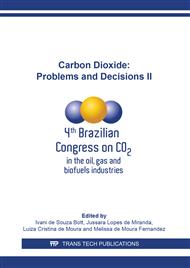p.29
p.39
p.49
p.59
p.69
p.79
p.87
p.97
p.107
Porosity Alteration of Carbonates by CO2-Enriched Brine Injection
Abstract:
Carbon dioxide (CO2) is considered one of the main gases that cause global warming. In this perspective, its injection in aquifers and oil and gas reservoirs has been a possible alternative to reduce its emission in the atmosphere. An alternative strategy in which CO2 is used efficiently in the Oil Industry is the Carbonated Water Injection (CWI), where the carbon dioxide is injected through the reservoir dissolved in the brine, eliminating problems of gravitational segregation and low sweeping efficiency present in other gas injection methods. Once injected, the fluid may react with the carbonate rock and inducing their dissolution, causing changes in the petrophysical properties of the rock. This work investigated changes in the average porosity of carbonate samples from Brazilian reservoir through a dynamic flow test with enriched brine with 100% CO2 injection under high pressure and high temperature conditions and simulating a region around the face of the injector well, with an injection pressure of 8,500 psi, a temperature of 70 °C and a flow rate of 2cm3/min. The core-flooding experimental setup includes two coreholders arranged in series with samples confined in its interior, which are swept by X-ray Computed Tomography (CT), taking measurements of average porosity data. The results showed that there was dissolution in the sample assembled in the first coreholder since the porosity had increased, while in the second, no significant alterations of the porosity were observed (around 8.5% of its initial value). This observation can still be confirmed by the analysis of the dissolved moles, which exhibit behavior similar to the porosity, indicating that some minerals actually suffered dissolution from the injection of carbonated brine.
Info:
Periodical:
Pages:
69-77
Citation:
Online since:
July 2019
Price:
Сopyright:
© 2019 Trans Tech Publications Ltd. All Rights Reserved
Share:
Citation:


